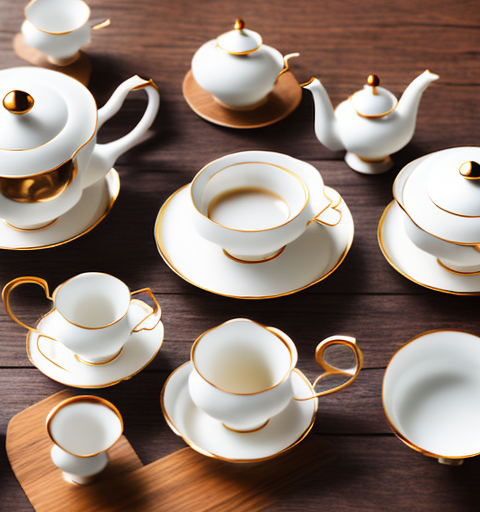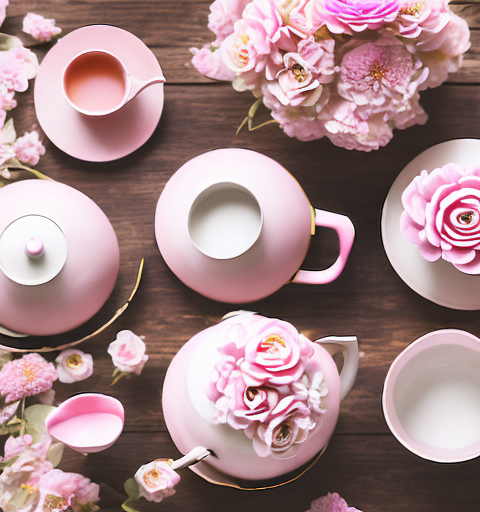One of the joys of owning a teapot with a vintage-inspired design is the charming aesthetic it brings to your tea-drinking experience. However, over time, tea stains can accumulate on the ceramic lid, diminishing its pristine appearance and overall allure. In this article, we will explore the importance of maintaining the ceramic lid of your vintage-inspired teapot and delve into various methods for removing tea stains without damaging the design.
Understanding the importance of maintaining the ceramic lid of a vintage-inspired teapot
Maintaining the ceramic lid of a vintage-inspired teapot goes beyond just preserving its visual appeal. The lid is an essential component that helps retain heat and flavors during steeping. Tea stains on the lid can affect the taste of your tea and even lead to the growth of bacteria if left unaddressed. Therefore, it is crucial to give proper attention to the cleanliness of the lid in order to ensure a delightful tea-drinking experience.
In addition to affecting the taste and potentially harboring bacteria, neglecting the cleanliness of the ceramic lid can also lead to discoloration and deterioration over time. Regular cleaning and gentle handling can help prevent the lid from becoming stained or damaged, preserving its original beauty and functionality. It is recommended to use mild dish soap and a soft sponge or cloth to clean the lid, avoiding abrasive materials that could scratch the surface. By taking proper care of the ceramic lid, you can extend the lifespan of your vintage-inspired teapot and continue to enjoy its charm for years to come.
Exploring the common causes of tea stains on ceramic lids
Tea stains on ceramic lids can result from various factors. One common cause is the tannins present in tea, which can oxidize and leave behind unsightly stains. Additionally, the porous nature of ceramic can make it susceptible to absorbing color pigments from tea, leading to discoloration. Other factors that contribute to tea stains include the temperature of the tea, brewing time, and the frequency of usage. Understanding these causes can help you implement effective stain removal techniques.
Another factor that can contribute to tea stains on ceramic lids is the type of tea used. Different types of tea, such as black tea, green tea, or herbal tea, contain different levels of tannins and pigments. For example, black tea tends to have higher levels of tannins, which can result in more stubborn stains. Similarly, certain herbal teas may contain natural dyes that can easily transfer onto ceramic surfaces. Therefore, the type of tea you choose to brew can play a role in the severity of tea stains on ceramic lids.
Assessing the impact of tea stains on the aesthetic appeal of a vintage-inspired teapot
The presence of tea stains on the ceramic lid of a vintage-inspired teapot can significantly impact its overall aesthetic appeal. The beauty of a vintage design lies in its intricate patterns and delicate details, which can be overshadowed by unsightly tea stains. However, it is important to approach stain removal with caution to avoid damaging the design or causing further discoloration.
One method for removing tea stains from a vintage-inspired teapot is to create a paste using baking soda and water. Gently apply the paste to the stained area and let it sit for a few minutes before scrubbing with a soft brush or cloth. Rinse thoroughly with warm water to remove any residue.
Another option is to use a mixture of white vinegar and water. Soak a cloth in the solution and gently dab the stained area, being careful not to saturate the teapot. Allow the vinegar mixture to sit for a few minutes before wiping clean with a damp cloth. Repeat if necessary until the tea stains are completely removed.
Step-by-step guide to removing tea stains from a ceramic lid without damaging the vintage-inspired design
When it comes to removing tea stains from a ceramic lid, it is crucial to take a gentle and cautious approach. Here is a step-by-step guide to help you effectively remove tea stains without damaging the vintage-inspired design:
- Start by rinsing the lid with warm water to loosen any loose tea residue.
- Mix a mild dishwashing detergent with warm water to create a gentle cleansing solution.
- Using a soft sponge or cloth, gently scrub the stained areas in circular motions. Avoid using abrasive materials that may scratch the surface of the lid.
- Rinse the lid thoroughly to remove any detergent residue.
- If the stains persist, create a paste using baking soda and water.
- Apply the paste to the stained areas and let it sit for a few minutes.
- Gently scrub the stains using a soft brush or toothbrush.
- Rinse the lid thoroughly and inspect for any remaining stains.
- If necessary, repeat the process or consider alternative cleaning methods.
It is important to note that different types of tea stains may require different cleaning methods. For example, stubborn stains caused by black tea may require a stronger cleaning solution or a longer soaking time. Experiment with different techniques to find the most effective method for your specific tea stains.
Additionally, if the ceramic lid has intricate designs or delicate patterns, it is advisable to test any cleaning solution on a small, inconspicuous area first to ensure that it does not cause any damage or discoloration. This will help you determine the suitability of the cleaning method for your specific ceramic lid.
Choosing the right cleaning products for safely removing tea stains from a ceramic lid
When selecting cleaning products to remove tea stains from a ceramic lid, it is important to choose options that are safe for use on delicate surfaces. Avoid harsh chemical cleaners, as they may damage the vintage-inspired design or leave behind residue. Look for gentle dishwashing detergents, baking soda, or natural cleaning solutions that are specifically formulated for ceramic surfaces.
Another important factor to consider when choosing cleaning products for tea stains on a ceramic lid is the type of tea that caused the stain. Different teas can leave behind different types of stains, such as tannin stains or pigmented stains. It is helpful to identify the type of stain before selecting a cleaning product, as certain products may be more effective at removing specific types of stains.
In addition to selecting the right cleaning product, it is also important to use the proper cleaning technique. For tea stains on a ceramic lid, it is recommended to create a paste using the chosen cleaning product and a small amount of water. Gently apply the paste to the stained area and let it sit for a few minutes to allow the cleaning agents to work. Then, using a soft cloth or sponge, gently scrub the stained area in a circular motion. Rinse the lid thoroughly with water and dry it with a clean, lint-free cloth to prevent any water spots or streaks.
Natural remedies for removing tea stains from a vintage-inspired teapot’s ceramic lid
If you prefer to use natural remedies to remove tea stains from your vintage-inspired teapot’s ceramic lid, there are several household items you can utilize. Lemon juice, white vinegar, and baking soda are wonderful natural cleansers that can effectively break down stains. Simply apply one of these substances to a soft cloth or sponge and gently scrub the stained areas. Rinse thoroughly afterward to remove any residue and enjoy a revitalized ceramic lid.
In addition to lemon juice, white vinegar, and baking soda, another natural remedy that can be used to remove tea stains from a vintage-inspired teapot’s ceramic lid is hydrogen peroxide. Hydrogen peroxide is a mild bleaching agent that can help lift stubborn stains. To use hydrogen peroxide, dampen a cloth or sponge with the solution and gently scrub the stained areas. Rinse thoroughly afterward to remove any residue. However, it is important to note that hydrogen peroxide may have a bleaching effect on certain colors or materials, so it is recommended to test it on a small, inconspicuous area first.
Expert tips and tricks for preventing tea stains on a teapot’s ceramic lid in the first place
Preventing tea stains on a teapot’s ceramic lid can help maintain its pristine appearance and save you from the hassle of frequent stain removal. Here are some expert tips and tricks to help prevent tea stains in the first place:
- After each use, rinse the ceramic lid with warm water to remove any tea residue.
- Consider using a damp cloth to wipe the lid gently after rinsing.
- Avoid leaving brewed tea in the teapot for prolonged periods, as this can increase the likelihood of stains.
- Store your teapot in a clean and dry environment when not in use.
- Regularly inspect the lid for signs of stains and address them promptly to prevent deeper discoloration.
Additionally, you can try using a ceramic lid with a non-stick coating. This can help prevent tea stains from adhering to the surface and make cleaning easier.
Another tip is to avoid using abrasive cleaning tools or harsh chemicals on the ceramic lid. These can damage the surface and make it more prone to staining. Instead, opt for gentle cleaning methods such as using a soft sponge or cloth.
Exploring alternative cleaning methods for stubborn tea stains on a vintage-inspired teapot’s ceramic lid
In some cases, tea stains can be stubborn and require alternative cleaning methods. If gentle scrubbing and natural remedies do not fully remove the stains, you may consider using a ceramic-safe stain remover or even consulting a professional cleaning service. However, exercise caution when using such options, as they may carry potential risks or affect the vintage-inspired design of the teapot’s lid.
One alternative cleaning method for stubborn tea stains on a vintage-inspired teapot’s ceramic lid is to create a paste using baking soda and water. Apply the paste to the stained area and let it sit for a few minutes before gently scrubbing with a soft cloth or sponge. Baking soda is known for its mild abrasive properties, which can help lift and remove stains without damaging the ceramic surface.
Another option is to use white vinegar as a natural cleaning agent. Mix equal parts of white vinegar and water in a spray bottle and spritz the stained area. Let the solution sit for a few minutes before wiping it off with a clean cloth. The acidity of the vinegar can help break down the tea stains and restore the teapot’s lid to its original condition.
Assessing the pros and cons of DIY cleaning methods versus professional cleaning services for tea stain removal
When deciding between DIY cleaning methods and professional cleaning services for tea stain removal, it is important to weigh the pros and cons. DIY methods provide convenience and cost-effectiveness, but there is a risk of causing unintentional damage to the vintage-inspired design. On the other hand, professional cleaning services offer expertise and specialized techniques but may involve additional costs. Consider your specific teapot and the severity of the stains before making a decision.
It is also worth considering the time and effort required for each option. DIY cleaning methods may require more time and effort on your part, as you will need to gather the necessary supplies and follow the instructions carefully. Professional cleaning services, on the other hand, can save you time and effort as they have the expertise and equipment to efficiently remove tea stains from your teapot.
How regular maintenance can help prevent future tea stains on a vintage-inspired teapot’s ceramic lid
Implementing a regular maintenance routine can prove instrumental in preventing future tea stains on the ceramic lid of your vintage-inspired teapot. By consistently rinsing the lid, gently wiping away any residue, and addressing stains promptly, you can significantly reduce the likelihood of deep-seated stains. Additionally, storing the teapot in a clean and dry environment can help maintain its overall quality and minimize the chances of staining.
Furthermore, using a specialized ceramic cleaner can also aid in preventing tea stains on the lid. These cleaners are designed to effectively remove stubborn stains without damaging the delicate ceramic surface. It is important to follow the instructions provided by the cleaner manufacturer to ensure safe and effective use.
Understanding the potential risks of using harsh chemicals to remove tea stains from a teapot’s ceramic lid
While harsh chemicals may provide powerful stain-removal capabilities, they also come with potential risks. Using aggressive chemical cleaners can damage the delicate vintage-inspired design of a teapot’s ceramic lid, causing fading, discoloration, or even structural deterioration. It is essential to prioritize the preservation of the lid’s aesthetic appeal when deciding on stain removal methods.
One alternative to using harsh chemicals is to opt for natural cleaning solutions. For example, a mixture of baking soda and water can be used to create a gentle paste that effectively removes tea stains without causing any harm to the ceramic lid. Additionally, using a soft cloth or sponge to gently scrub the stained area can help minimize the risk of damage. It is important to test any cleaning solution on a small, inconspicuous area of the lid before applying it to the entire surface to ensure compatibility and avoid any potential adverse reactions.
Exploring alternative ways to preserve and enhance the vintage-inspired design of a teapot’s ceramic lid
If you wish to preserve and enhance the vintage-inspired design of a teapot’s ceramic lid, there are various alternative methods you can explore. Applying a ceramic-safe sealant or wax can provide an additional layer of protection against stains and offer a subtle sheen to the lid’s design. Additionally, gentle polishing with a microfiber cloth or using ceramic-specific cleaning and brightening products can help bring out the intricate details of the vintage-inspired design.
Troubleshooting common challenges faced when trying to remove tea stains from a vintage-inspired teapot’s ceramic lid
Despite taking precautions and following recommended cleaning methods, you may encounter challenges when attempting to remove tea stains from a vintage-inspired teapot’s ceramic lid. Some common challenges include deep-seated stains, fading of the design, or unexpected reactions between cleaning agents and the lid’s surface. In such cases, it is advisable to consult experts in teapot restoration or seek professional advice to overcome these challenges effectively.
Incorporating regular cleaning routines to maintain the pristine appearance of a teapot’s ceramic lid with a vintage-inspired design
To maintain the pristine appearance of a teapot’s ceramic lid with a vintage-inspired design, it is essential to incorporate regular cleaning routines into your tea-drinking regimen. By making a habit of rinsing the lid after each use, using gentle cleaning methods, and promptly addressing any stains, you can preserve the lid’s aesthetic appeal and enjoy many more delightful tea sessions with your vintage-inspired teapot.
In conclusion, removing tea stains from the ceramic lid of a teapot with a vintage-inspired design requires a delicate touch and thoughtful approach. By understanding the importance of lid maintenance, exploring various stain removal methods, and taking preventive measures, you can keep your teapot’s lid in pristine condition while preserving its captivating vintage charm. Remember to balance effectiveness with the protection of the lid’s design, and enjoy your tea with a renewed sense of visual delight.






